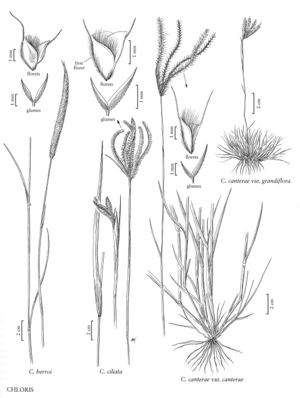Difference between revisions of "Chloris canterae var. grandiflora"
Introduced
Treatment appears in FNA Volume 25. Treatment on page 208.
imported>Volume Importer |
imported>Volume Importer |
||
| Line 40: | Line 40: | ||
|publication year= | |publication year= | ||
|special status=Introduced | |special status=Introduced | ||
| − | |source xml=https://bitbucket.org/aafc-mbb/fna-data-curation/src/ | + | |source xml=https://bitbucket.org/aafc-mbb/fna-data-curation/src/200273ad09963decb8fc72550212de541d86569d/coarse_grained_fna_xml/V25/V25_795.xml |
|subfamily=Poaceae subfam. Chloridoideae | |subfamily=Poaceae subfam. Chloridoideae | ||
|tribe=Poaceae tribe Cynodonteae | |tribe=Poaceae tribe Cynodonteae | ||
Latest revision as of 17:58, 11 May 2021
Plants densely cespitose. Culms 5-30 cm. Leaves primarily basal, 1-1.5 mm wide, involute. Panicles with 3-5 branches; branches 3-6 cm. 2n = unknown.
Discussion
Chloris canterae var. grandiflora was collected around woolen mills in southeastern North America in the nineteenth and early twentieth centuries. It has also been found in Texas, but less frequently than var. canterae. In South America, it grows in drier, more rocky areas than var. canterae.
Selected References
None.
Lower Taxa
None.
... more about "Chloris canterae var. grandiflora"
Mich. +, Del. +, Ariz. +, N.Mex. +, Pacific Islands (Hawaii) +, Miss. +, Tenn. +, Fla. +, Wyo. +, Puerto Rico +, N.J. +, Tex. +, La. +, N.C. +, S.C. +, Pa. +, Conn. +, Mass. +, Maine +, N.Y. +, Nev. +, Va. +, Colo. +, Virgin Islands +, Calif. +, Ala. +, Kans. +, N.Dak. +, Nebr. +, Okla. +, S.Dak. +, Ark. +, Ill. +, Ga. +, Ind. +, Iowa +, Md. +, Ohio +, Oreg. +, Utah +, Mo. + and Ky. +
Present +
Introduced +
Chloris canterae var. grandiflora +
Chloris canterae +
variety +
